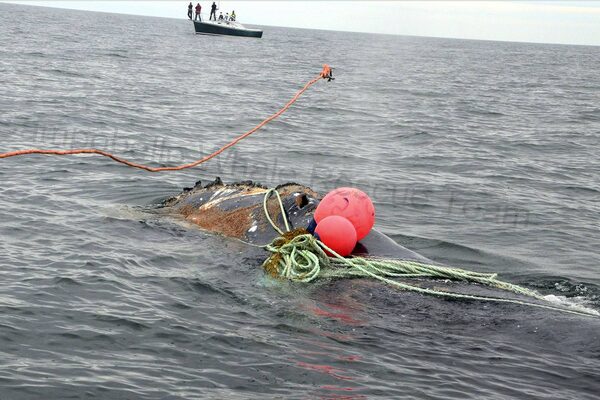
Campobello Whale Rescue Team members work to disentangle a right whale in in the Bay of Fundy in August, 2016.Picasa
The federal government has imposed four new rules for the snow crab fishery as a first step towards lowering the risk to the imperilled North Atlantic right whale following last summer's mass die-off in Canadian waters. However, some experts say the measures do little to reduce the threat to the critically endangered species.
"Protecting Canada's endangered whales from further harm is a responsibility that weighs heavily on all of us," Fisheries Minister Dominic LeBlanc said on Tuesday in Moncton.
In a span of just months last year, nearly 4 per cent of the world's population of right whales died due to ship strikes and fishing gear entanglements. The bulk of fatalities – 12 of 17 – was discovered in Canada's Gulf of St. Lawrence, a semi-enclosed fishing and shipping area bordering the Atlantic Provinces and Quebec. Approximately 450 right whales are left in the world and only about 100 are reproducing females. Last year, just five births were recorded.
Tonya Wimmer, of the Marine Animal Response Society, said preventing entanglements comes down to avoiding unnecessary animal cruelty in addition to protecting the species.
"It is a horrible way for any of these animals to die," she said, referencing the last necropsy which involved a two-year-old female that had deep cuts from fishing rope and gear trailing out of her mouth, leading to her drowning death after getting tightly wrapped in the rope. "This is akin to animals getting caught in old bear traps and they have to sit there and no one finds them."
Eighty-five per cent of right whales have scars from a rope entanglement with fishing gear, and another 50 per cent from a second encounter. The new regulations include reducing the amount of surface rope in the water and adding gear identification to track where entanglements happen.
Previously, there were no restrictions on the amount of rope snow crab fishermen could use between the pair of buoys attached to each snow crab pot. (There are two buoys because one is used as a backup to mark the location and to help retrieve crab pots in rough weather or heavy tides.) Under the new rules, fishermen are restricted to 3.7 metres of rope between buoys.
"In many cases, metres and metres of rope previously had been allowed to float on the surface. That will be ended for this season," Mr. LeBlanc said.
Once the trap is set, fishermen will now have to use weighted rope to keep the line vertical between the snow crab trap and buoy to prevent excess rope floating the surface.
Ms. Wimmer said she didn't think the rope reduction rules will have much impact when the whales return to the Gulf in late May or June.
"From our understanding, from some of the fishermen we've spoken to – a lot of them already fish according to that idea," she said. "They've been doing this a long time and often use only as much rope as they need, because it is also a business decision in terms of an expense."
Fishermen will also be required to use colour-coded ropes to help identify the area of an entanglement, and buoys are to be marked with a sequential number. Additionally, fishermen will be required to report lost gear and the last known GPS position of it.
Mr. LeBlanc said weeks after the snow crab season closed last summer, a significant amount of lost or abandoned fishing gear was still floating in the Gulf.
Brian Adams, of Pleasant Bay, N.S., represented the North of Smokey Fishermen's Association at the minister's roundtable on right whales in November. He said snow crab fishermen made these recommendations, along with earlier fishing seasons if the ice conditions allow. "The number one focus was to avoid any further kills and if that did happen, it would help identify further action if it had to be taken," he said. "It's like anything, when you get to the drawing board at something, you try to produce your best knowledge and see if that works, and it's not to say it's inclusive, but you have to start somewhere. It's a good start."
Mr. LeBlanc said additional measures will be announced in a few weeks. He said the government is looking at modifying fishing gear and adjusting fishing seasons.